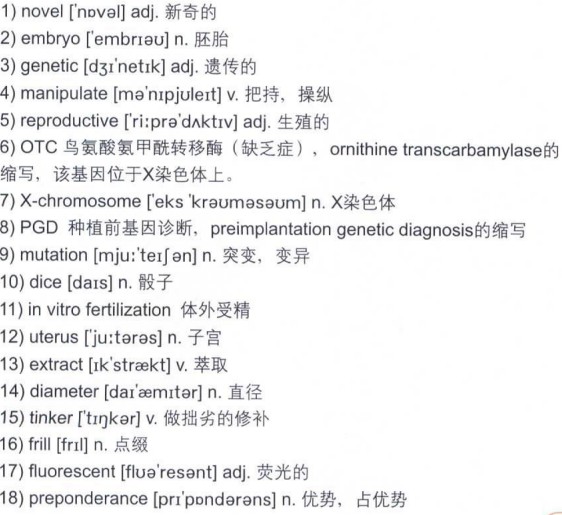发音:美式发音 语速:170词/分钟 使用方法:泛听+讨论
 科学的发展是一把可怕的双刃剑。
科学的发展是一把可怕的双刃剑。
一百年前,女人分娩还是一场生与死的对簿;如今,剖腹产、无痛分娩大大降低了女性分娩的危险,甚至连“试管婴儿”这类人工受孕方式也已经发展到第三代——即在受孕开始就对胚胎细胞进行萃取分析,以判断是否带有遗传性疾病,甚至可以选择胎儿的性别!
选择胎儿的性别——这就是一切伦理讨论的矛盾所在。有人说,孩子是上天赐予的礼物,即使身为父母,也没有选择的权利;有人说,保证孩子的健康才是一切的基准;有人说,我只是想要一个女孩/男孩,这又有何不可?
于是科学与伦理,无可避免地站成两个对立面。
那么,您呢?如果你有一个孩子,你会选择它的性别吗?
Adding to your family has always involved a bit of mystery; will it be a boy, will it be a girl? We know the science exists to help select sex, but now gender selection is more accurate than ever, going from 1)novel to more mainstream. The technology was originally created to identify 2)embryos with 3)genetic diseases, but critics are troubled by the use of this technology for a non-medical reason. Some say even preventing genetic disorders 4)manipulates Mother Nature.
迎接一个新的家庭成员总是或多或少掺杂了些神秘色彩——会是个男孩,还是个女孩?我们知道科学能帮我们辨别性别,但现在性别选择的精确度比以往任何时候都高,而且慢慢从尖端前卫走向主流。这项技术原本是为了尽早辨别出带有遗传疾病的胚胎而创,但如今,评论家们开始担心这项技术被用于非医疗目的。有人甚至说,阻止这种基因突变本身就已经违背了自然规律。
So where do we draw the line? The rapid growth of genetic technology is changing the practice of medicine and also presenting some complex practice decisions, so we’re gonna introduce you to some families who are making 5)reproductive decisions that weren’t even possible 20 years ago. What would you choose?
Melissa: I was put on this earth to be a mother. I knew that always. I’ve always knew (known) I was gonna be a mother.
Reporter: Yet this was a long road for you.
Melissa: Absolutely. It was a very long journey. (Melissa speaking to her baby) Here we go.
Two years ago before baby Morgan was born, Steve and Melissa had baby Walker, who experienced health problems just hours after birth.
Reporter: How did they tell you? What did they tell
you initially?
Steve: You’re in for a roller coaster ride. I think at that time they knew what the end was going to be, but…
Melissa: They suspected…
Steve: …they suspected, and I’m fairly certain they knew at that point in time that it was not going to be a
long term.
Melissa: He wasn’t gonna live…long.
Walker never made it out of the hospital. He died when he was just 19 days old. But their worst nightmare was not yet over. Doctors told them Walker died from a genetic disorder called 6)OTC, and it was carried over from Melissa’s 7)X-chromosome. Any future children would have a 50% chance of the same condition.
Melissa: They gave us several options, you know, obviously you could try this naturally again and roll the dice. To me 8)PGD was the only option and it was never a “should we, shouldn’t we”. It was “okay, we’re gonna”.
Reporter: Pre-implantation Genetic Diagnosis.
Melissa: Yes.
Dr. Mark Hughes (Genesis Genetics Institute): (looking at the computer screen) Embryos 2 and 7 have the
9)mutation and shouldn’t be transferred.
Dr. Hughes: The frustrations that I had was (were) that I would meet with couples all the time, who just found out that they had a baby with a serious inherited disease.
Geneticist Dr. Mark Hughes channeled this frustration into a search for alternatives.
Dr. Hughes: These poor couples were basically faced with throwing the genetic 10)dice, hoping against hopes the dice don’t come up the wrong way, and so we imagined making the diagnosis before they got pregnant even in the first place, which was science fiction at the time.
It was 20 years ago that science fiction turned into fact. Embryos could now be tested for genetic disease.
Dr. Hughes: We all have these things in our DNA that we’re not aware of until, out of the blue, they strike
our family.
(Dr. Hughes and his working staff talking simultaneously)
Dr. Hughes: This is a normal embryo that’s unaffected.
Working staff: So that one’s healthy?
Dr. Hughes: Okay.
Working staff: Right.
PGD requires the couple go through the 11)in vitro fertilization process normally used for fertility issues, but in PGD before transferring fertilized embryos back into the 12)uterus, they are tested to avoid those that test positive for the inherited disease.
Dr. Hughes: All right, so Embryo 1 looks good.
Dr. Hughes’ lab is one of just a handful around the world that does the testing. In vitro happens for the couple at their local fertility clinic. From there, a single cell is 13)extracted from each embryo by a tiny straw 1/25 the 14)diameter of a human hair, and express shipped to Dr. Hughes in the US state of Michigan.
Dr. Hughes: Technology allowed us to test the smallest unit of life—one cell—for the smallest unit of inheritance—one gene—for the smallest possible part of a gene.
The team then has less than 24 hours to sequence each embryo cell’s DNA so the ones free of disease can be put in the waiting woman’s uterus.
Baby Morgan is the result of PGD, a healthy embryo that Dr. Hughes was able to select for transfer.
Reporter: Did you ever think, “Okay, you know what, I don’t want to do anything that 15)tinkers with Mother Nature in any way”?
Steve: I never had any moral concerns about it. I look at it that there are people that have been blessed with the ability to come up with this research that…you know, it’s not an accident that people have gotten to this point.
Reporter: But you said, obviously, you wouldn’t ever use this technology, PGD, to do anything beyond creating a healthy child. What about people who do?
Steve: Other than health, I think it’s just a lot of expense for a little bit of 16)frill.
But there are some families who can afford what might seem like “a bit of frill”.
Bob: We looked at each other and said, “Wow, you know we’ve been trying for multiple years to have another child, and sort of gambling, well, why don’t we go ahead and make it so that we do have a boy”.
Bob and Mindy had four daughters, but felt their family wasn’t complete. Using PGD the couple was able to choose the sex of their child, resulting in twin boys.
Now gender selection is controversial and is banned in most countries. It is legal in the United States, but critics worry it could lead to “designer babies” based on societal preference.
Bob: We feel that as technology advances, we can take advantage to enhance our lives and the lives of others, it’s a good thing.
Dr. Jeffrey Steinberg (The Fertility Institutes): (looking at the pictures of the embryo) So here we’ve got a healthy boy and here we’ve got a healthy girl.
Los Angeles fertility specialist Dr. Jeffrey Steinberg says many of his American clients are like Bob and Mindy; they’re in search of family balancing.
Gender selection uses PGD technology to extract that single cell from each embryo. The cells are then studied under a high-powered 17)fluorescent microscope to determine their gender. Dr. Steinberg says 70% of his patients are international, seeking the procedure that’s banned in their home country.
Dr. Steinberg: If anything, there is a slight
18)preponderance of preference for female, and this is contrary to everything that is publicized, and clearly it varies by country. China; strongly in favour of boys, as we would suspect. India; strongly in favour of boys. But when you look at the world in general, it’s 50-50.
I say to critics that the last thing in the world that you want to do is put the handcuffs on science. We’ve been giving women expanded reproductive choices for 50 years, and this is another choice.
Dr. Hughes: Do we have the data on the Toronto couple?
Dr. Hughes, who’s the creator of PGD technology, has concerns about its use for a non-medical purpose.
Dr. Hughes: It definitely is an expanded reproductive choice. The question is, is it medicine? Is it something that doctors should be involved in?
A little girl undeniably also made possible by genetics, a field moving at such a rapid pace that the possibilities and the ethical debates seem endless.

那我们该如何定下这条基准线呢?基因遗传技术的快速发展正在改变着医学的面貌,也为我们提供了一些复杂而现实的选择。我们接下来为大家介绍几个家庭的故事,他们做出了20年前根本无从想象的选择生育的决定。而你又会怎么选
择呢?
梅丽莎:我生于世就为了做母亲,我一直都清楚这一点。我一直都相信我会成为一个母亲。
记者:不过这对你来说是一条漫长的
道路。
梅丽莎:没错,这真的是一段漫长的征途。(梅丽莎对着孩子说)我们走。
两年前,小家伙摩根出生之前,史蒂夫和梅丽莎曾经生下一个叫沃克的孩子。他出生几个小时后就遭遇了健康问题。
记者:他们(医生)怎么跟你们说的?一开始他们说了些什么?
史蒂夫:就好像过山车一样,我们从兴奋到失望。我觉得他们从一开始就知道结果会怎样,但是……
梅丽莎:他们有怀疑……
史蒂夫:……他们的确有怀疑,而我也非常肯定他们从那一刻开始就知道这事不会拖得很久。
梅丽莎:孩子活不长……
沃克没有熬到可以出院的那天。在刚满19天的时候,他离开了这个世界。但是他们(史蒂夫夫妇)的噩梦并没有结束。医生告诉他们,沃克死于一种叫OTC的基因遗传病,而这个基因正好位于梅丽莎所携带的X染色体上。因此,他们以后所生的小孩也有50%的可能会得同一种病。
梅丽莎:他们告诉我们有几个选择,你知道,就是你们当然还可以尝试自然受孕,让上天决定一切。对于我来说,PGD就是唯一的选择。它不是一个“我们应不应该这么做”的问题,而是一个“好吧,我们必须去做”的问题。
记者:胚胎植入前基因诊断。
梅丽莎:是的。
马克·休斯医生(美国遗传基因机构):(看着电脑屏幕)2号胚胎和7号胚胎有突变现象,不适合被移植。
休斯医生:让我感到挫败的是我经常会遇到许多夫妇,他们才刚发现他们的孩子生来带有严重的遗传疾病。
遗传学者马克·休斯医生把这种挫败转化为研究解决方法的动力。
休斯医生:这些可怜的夫妻们基本上都必须面对基因的命运之骰,希望骰子不要转到错误的一面,于是我们试着想象可以在最开始他们怀孕之前就对基因作出诊断,这在当时还是天方夜谭。
但是在20年前,这如“天方夜谭”般的情节变成了现实。现在,我们可以通过对胚胎的测试来判断它是否有基因遗传
疾病。
休斯医生:我们没有意识到这些疾病就存在于我们的DNA里,直到有一天,悲剧发生在我们家里。
(休斯医生和他的工作人员在讨论)
休斯医生:这颗胚胎是正常的,没有受
感染。
工作人员:所以这一颗是健康的?
休斯医生:对的。
工作人员:好的。
PGD要求每对夫妇都必须经过通常为受孕成功而进行的体外受精全过程,但是如果采用PGD技术,工作人员会在把受精卵移植回母体子宫之前,对其进行测验,以求确定它不带任何遗传性疾病。
休斯医生:好的,1号胚胎看起来很正常。
休斯医生所创办的这家实验室是世界上为数不多的几家可以测试胚胎健康的实验室之一。体外受精的阶段可以在普通夫妇所就诊的医疗所完成。在那里,医生可用一根直径只有人类头发的二十五分之一长的微管,在每个胚胎上各抽取一个细胞出来,然后把它打包快递送到位于美国密歇根州休斯医生的实验室来。
休斯医生:科技让我们可以对一个最小的生命单位——即一个细胞——进行测试,以此来判断遗传的最小单位——一个基
因——的一切可能存在的问题。
然后(休斯医生的)工作团队可以在24小时以内把每个胚胎细胞的DNA顺序排列出来,选择没有携带病基的那些胚胎移植入母体子宫中。
摩根就是PGD的产物,是由休斯医生所选择的一个健康胚胎发展而来的。
记者:你有没有想过说,“好吧,你知道吧,我不想做任何违背自然规律的
事情”?
史蒂夫:我从来没考虑过道德方面的问题。我对这件事的看法就是,上帝赋予了一些人能力,让他们能研究出这项技术
让……你知道,这一切发展至今绝不是
偶然。
记者:但是你也说过,很显然,你绝不会利用这项技术,PGD,去做任何不是以创作一个健康的宝宝为目的的事。那其他那些这么做的人呢?
史蒂夫:除却健康的原因,我觉得那只是为一点小点缀(这里指增加不同性别的孩子)而浪费大量金钱而已。
但还是有一些家庭可以承担这看起来只是为增加一点“小点缀”而需的费用。
鲍勃:我们看着对方说:“哇,你知道我们已经用了好多年时间尝试再要一个小孩,而这就像赌博一样,既然如此,我们何不径直去做呢,这样我们可以确保我们生的是个儿子。”
鲍勃和明迪生了四个女儿,但他们仍觉得他们的家庭并不完整。通过PGD技术,这对夫妻可以选择自己孩子的性别,也因此得到了一对双胞胎儿子。
现在,性别选择颇具争议,许多国家都明令禁止这一行为。在美国,性别选择是合法的,但也有评论家担心这会导致由于社会偏好而产生的“设计婴儿”。
鲍勃:我们都觉得随着科技进步,我们能利用科技来增进我们以及其他人的生活,这是件好事。
杰弗里·斯坦恩伯格医生(美国生育研究所):(看着胚胎图)这边的是个健康的男性胚胎,而这边的是个健康女性胚胎。
来自洛杉矶的生育专家杰弗里·斯坦恩伯格医生说,他的美国顾客中多数都是像鲍勃和明迪这样的,他们希望能达到家庭的性别平衡。
性别选择就是通过PGD技术从每个胚胎中抽取一个细胞,再将这些细胞放在高精的荧光显微镜下进行研究,以辨别性别。斯坦恩伯格医生说,他的病人中有70%来自于世界各地,他们都希望可以在这里进行这项在他们本国被禁止的行为。
斯坦恩伯格医生:要说有区别的话,对女性性别的偏好稍占上风,这跟以往大众所宣传的刚好相反,而在不同的国家,情况也不尽相同。就我们猜测的,中国应该更倾向于男性;印度也有强烈的男性选择倾向。但是当你放眼全世界的话,比例大概是一半一半。
我(指记者)告诉评论家们说,我们万万不能给科学套上枷锁。50年来,我们给女性提供了生育的更多选择,而这个只是另一个选择而已。
休斯医生:我们有那对多伦多夫妻的资料吗?
休斯医生开创了PGD这项技术,他也非常关心它被用于非医疗目的的情况。
休斯医生:这的确是另一个生育选择。问题是:这是不是关于医疗的?这是不是医生该介入的领域?
毫无疑问,如果没有遗传学,这个小女孩无法降临于世,然而对于这个快速发展的领域而言,它能带来的科学可能性与伦理的讨论将永无休止。
各国的声音……
如果你有机会选择自己孩子的性别,你会吗?这是世界各国人民的一些想法。
So would you choose the gender of your baby if you could? Here’s (’re) some thoughts from around the world.
Moscow, Russia: Why create all that? Some people enjoy creating themselves—their own image. This is a live being. Everything about it is unexpected. It’s alive, it’s beautiful and unpredictable. It’s more interesting to live this way.
俄罗斯莫斯科:为什么要发明这些东西?有些人喜欢创造自己——有关他们的一切形象。生命就是个过程,一切都无法预料。它是鲜活的、美丽的、无法预计的。这样活着才更有趣。
Hong Kong, China: If it is safe I will choose a boy because I like boy and because you know, in Chinese, boy is very important than girl, [sic] and that’s what I choose.
中国香港:如果技术安全的话我会选择一个男孩,因为我喜欢男孩,还因为你知道,在中国人看来,男孩比女孩重要,所以这就是我的选择。
London, England: You spoil the surprise. You know, it’s like opening a present under the tree before Christmas Day. You need, you know, let it pop out and see what it is.
英格兰伦敦:你完全破坏了未知的惊喜。你知道,这就像你在圣诞树下打开礼物一样,你需要的只是,让它出现在你眼前并打开来看是什么。
Paris, France: No, definitely no, no, because child is a child and woman or boy…we don’t really care. We don’t really care. We have three children, three boys and we are very happy with them. Children have to come as they are and we don’t have to choose for the gender of the baby. So that’s it. We just get them as they come, right?
法国巴黎:不,当然不会。因为孩子就是孩子,不管女孩还是男孩,我们都不会太在意。真的。我们已经有三个孩子,都是男孩,拥有他们我们很开心。孩子就应该以他们原来的样子来到这世上,我们根本无需去选择孩子的性别。这就是我的答案。我们就让他们顺其自然,对吧?
South Africa: If I would have to choose the gender of my child, I wouldn’t. Because I think it’s not my place to choose whether it should be a girl or a boy.
南非:如果给我机会选择我孩子的性别,我不会这么做的。因为我觉得不管是男还是女,孩子的性别都不是我有资格去选择的。
CNN相关链接:http://edition.cnn.com/2009/HEALTH/12/08/video.wall.gender.baby/
